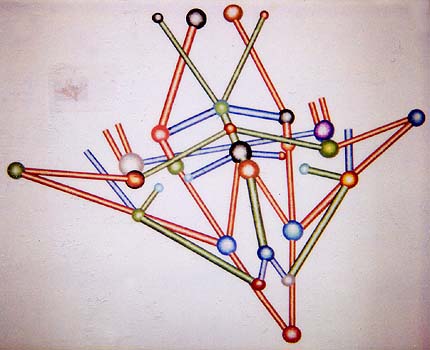I started an archive of the molecular wall-drawings I've been doing recently. I spent several years in the mid-'90s using this type of stick-and-ball model in paintings, drawing the struts and spheres in pencil and laboriously hand-rendering them with acrylic paint. (Now I hand-paint them in the computer, and frankly, the only thing missing is the repetitive stress injury in my wrist.) The constructions started out based on actual complex molecules, but then I started looking elsewhere for patterns: For example, in this piece from 1994, I snapped a photo of Curly Howard of the Three Stooges off the TV (from the short where he's a plumber and ineptly builds a cage of leaky pipes around himself) and used the cage as a model for a "molecule."
It just dawned on me recently that in all that work, I was somewhat pathetically regressing to the level of playing with tinkertoys, a product I had a love/hate relationship with as a child. I liked the look of them but they never really worked after you used them a few times, because the split ends of the wood sticks wore out and lost their spring. They fell right of the wooden "wheels" and nothing complicated could be built. In contrast, my molecules can be any shape because there are no guide-holes and gravity is not a factor. At any rate, thinking about that product led me to the Hasbro website, where I was amused and depressed to see that tinkertoys are still being made, for "pre-schoolers." My theory is that boomer parents only remember the good and not the bad aspects of the classic (read archaic) toy and want their kids to "experience the magic." One design caught my eye in a page of overly-complicated, somewhat loaded examples of tinkertoy constructions for tots to build: a stealth fighter, so the little Rummy or Condoleezza in your household can play Kill the Bad Taliban Man.
This led to my own molecular stealth fighter:

|
I started an archive of the molecular wall-drawings I've been doing recently. I spent several years in the mid-'90s using this type of stick-and-ball model in paintings, drawing the struts and spheres in pencil and laboriously hand-rendering them with acrylic paint. (Now I hand-paint them in the computer, and frankly, the only thing missing is the repetitive stress injury in my wrist.) The constructions started out based on actual complex molecules, but then I started looking elsewhere for patterns: For example, in this piece from 1994, I snapped a photo of Curly Howard of the Three Stooges off the TV (from the short where he's a plumber and ineptly builds a cage of leaky pipes around himself) and used the cage as a model for a "molecule."
It just dawned on me recently that in all that work, I was somewhat pathetically regressing to the level of playing with tinkertoys, a product I had a love/hate relationship with as a child. I liked the look of them but they never really worked after you used them a few times, because the split ends of the wood sticks wore out and lost their spring. They fell right of the wooden "wheels" and nothing complicated could be built. In contrast, my molecules can be any shape because there are no guide-holes and gravity is not a factor.
At any rate, thinking about that product led me to the Hasbro website, where I was amused and depressed to see that tinkertoys are still being made, for "pre-schoolers." My theory is that boomer parents only remember the good and not the bad aspects of the classic (read archaic) toy and want their kids to "experience the magic." One design caught my eye in a page of overly-complicated, somewhat loaded examples of tinkertoy constructions for tots to build: a stealth fighter, so the little Rummy or Condoleezza in your household can play Kill the Bad Taliban Man.
This led to my own molecular stealth fighter:
- tom moody 8-31-2002 3:18 am